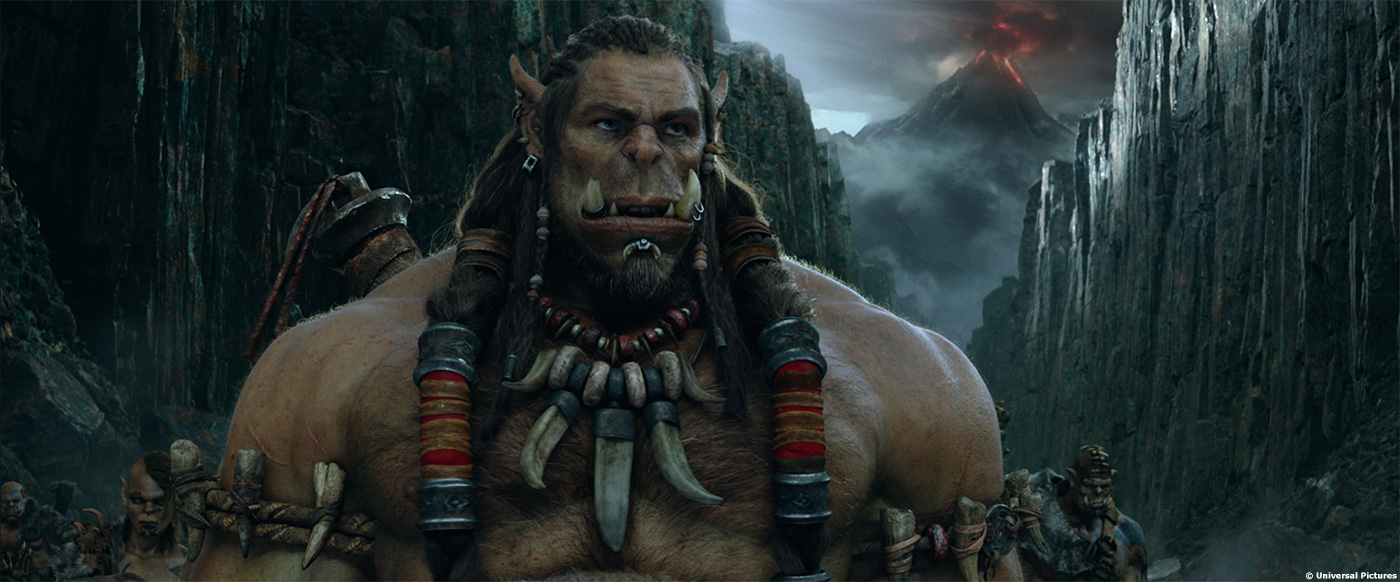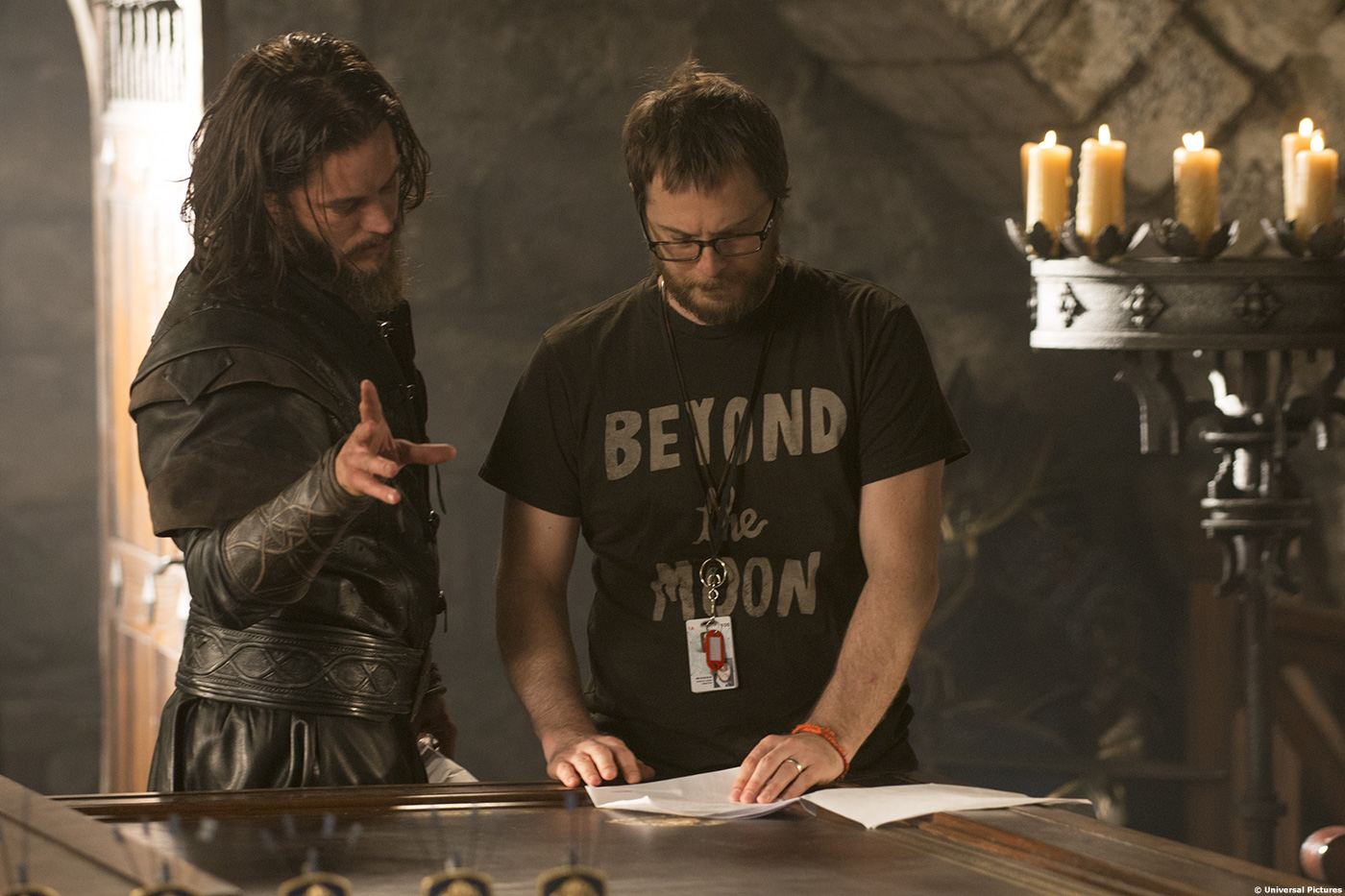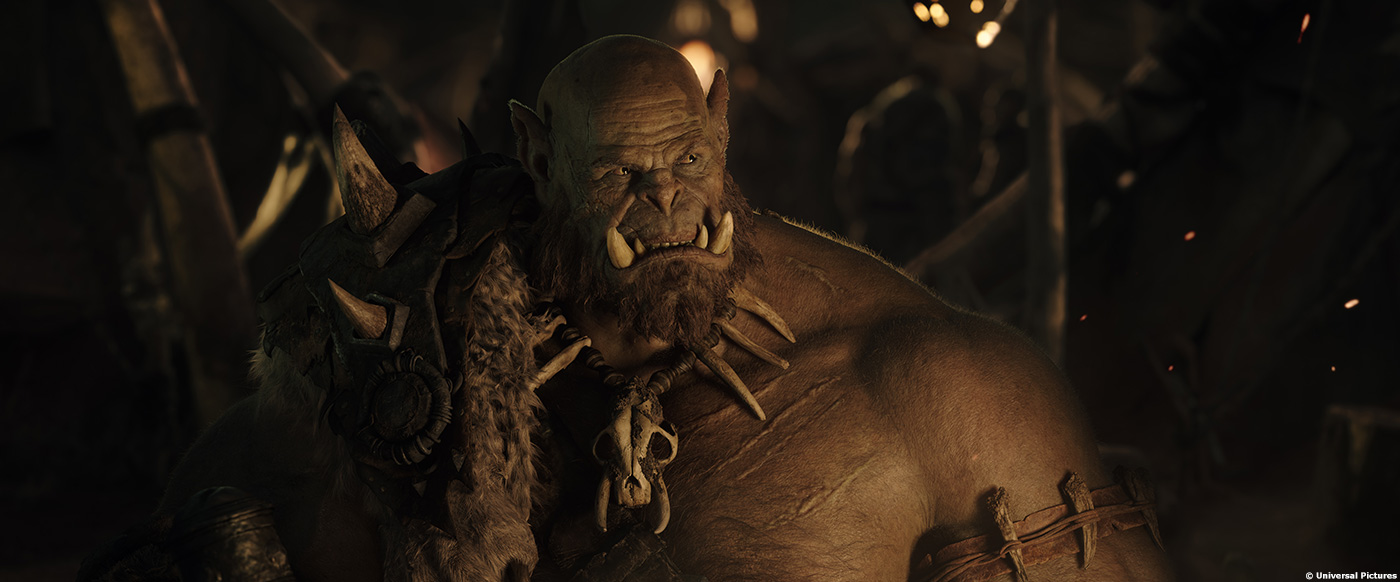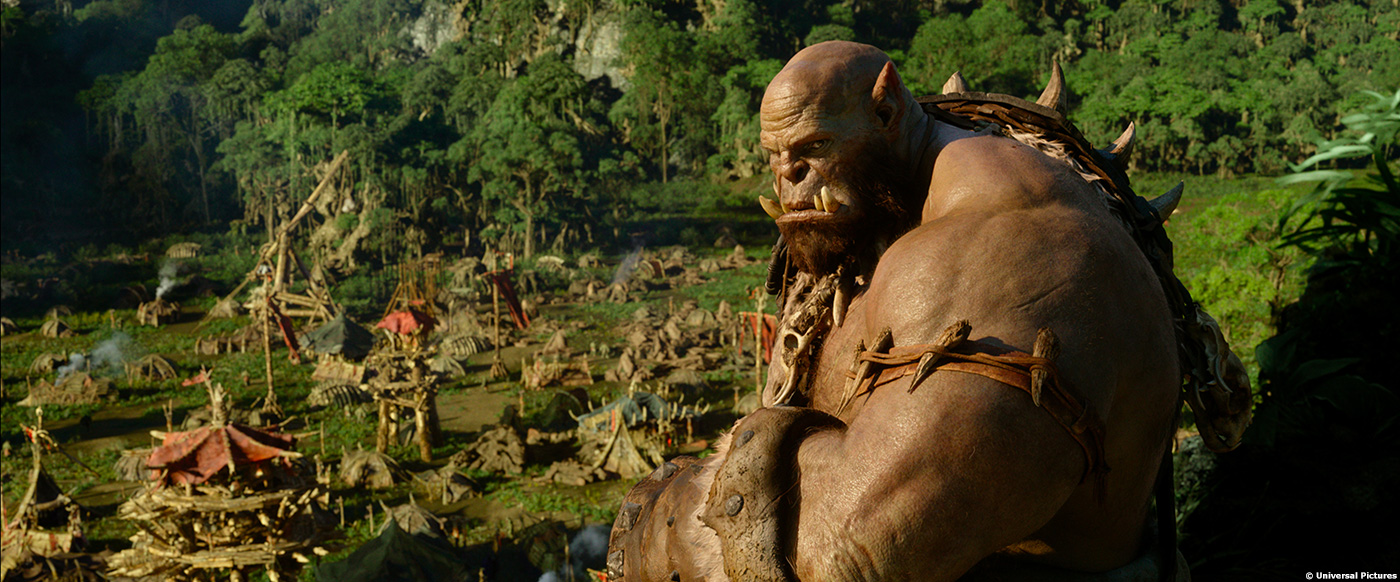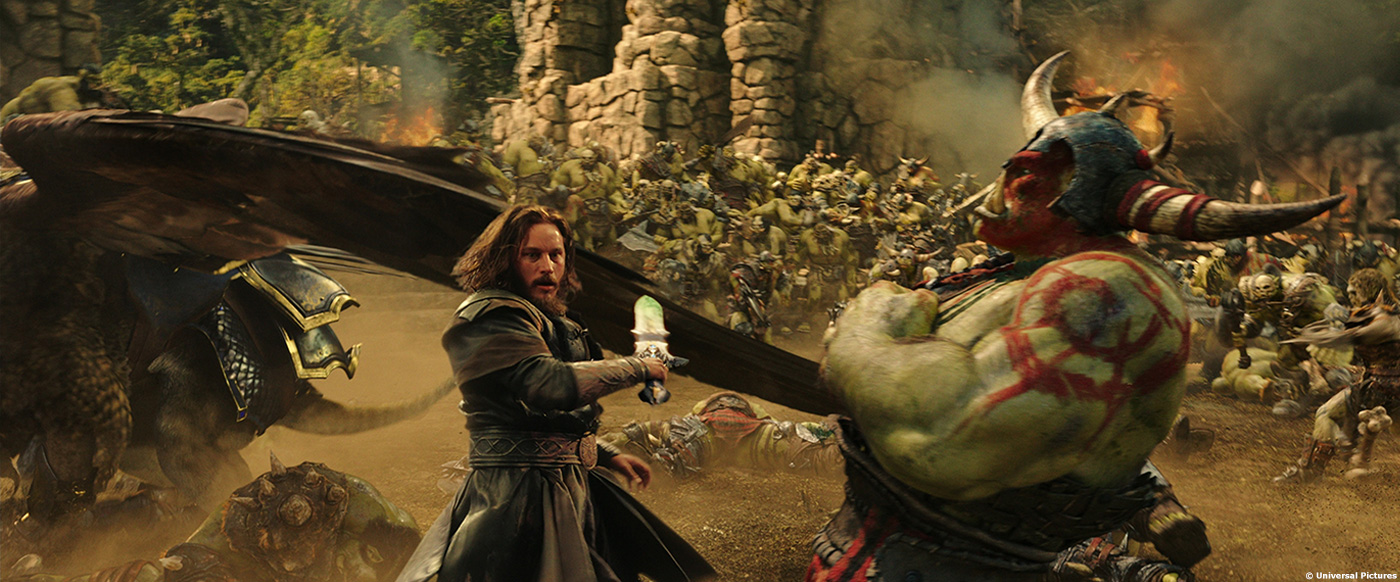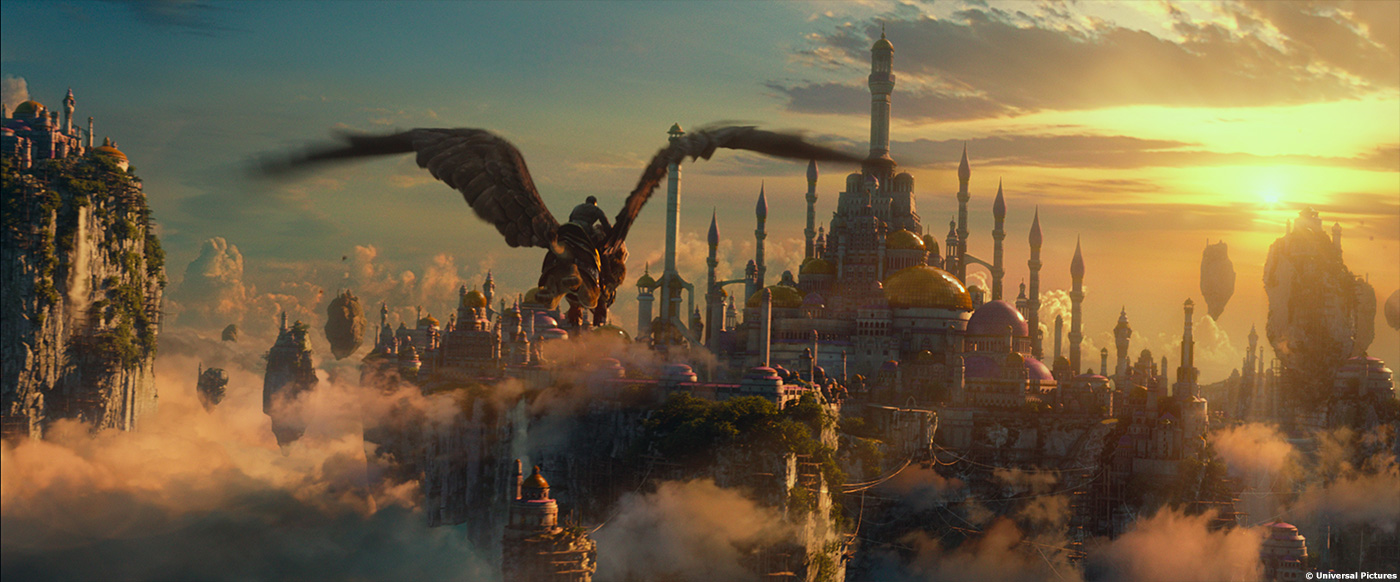In 2013, Hal Hickel had explained in detail about the work of ILM on PACIFIC RIM. He then moved from the giant robots to the Orcs of WARCRAFT.
How did you and ILM get involved on this show?
It began as a discussion between Duncan Jones and ILM Visual Effects Supervisor Jeff White in late 2012, which led to a meeting, then more meetings and then ILM created a proof of concept piece in early 2013 under Duncan’s direction, that was shown at ComicCon that summer.
I had just completed PACIFIC RIM, and so I was available and WARCRAFT was a good fit, so I was assigned to the project.
How did you work with director Duncan Jones and VFX Supervisor Bill Westenhofer?
Duncan and Bill are both great guys, very collaborative and very low ego. Our Visual Effects Supervisors on the ILM side (Jeff White, and Jason Smith), along with myself partnered with them right from the start to figure out how we wanted to approach the work. Duncan and Bill made a lot of trips up to ILM, and then we were on set throughout filming. Once we were in post-production, we would do several videoconference sessions weekly with Duncan and Bill to review all the work in progress.
What was your feeling to enter the world of Warcraft?
Unlike Duncan, Bill, Jeff, and Jason, I had never played World of Warcraft (or any of it’s earlier incarnations). However, my son Lex is an avid player, and very knowledgeable. He was my advisor on the film. That said, I’ve always enjoyed the fantasy genre, and since the lore of Warcraft is really a sort of love letter to Tolkien and everything that came after, I felt right at home in that universe.
How did you work with ILM VFX Supervisors Jeff White and Jason Smith?
I’ve known both Jeff and Jason for years, and they had worked together on films before, but this was the first film I had done with them. We got along great. Jeff and Jason both have a great eye, and had both recently worked on the Hulk for THE AVENGERS, which was good preparation for our Orc characters.
How did you organize the work with him and with your team?
Like most of our really big shows these days, the work was split up between several of our facilities worldwide. Some of it was done here in San Francisco, some at ILM Vancouver and some at ILM Singapore.
The first step is determining which sequences would be done at which facility. Then the animation leads in those studios (Kim Ooi in Singapore, and Cedric Lo in Vancouver) further broke down the work and assigned shots to individual animators. I did the same here in San Francisco. I would review the work from all the facilities and give them feedback, and then present it to Duncan when I felt it was at a good stage for feedback.
Which references and indications did you received from Duncan Jones for the animation?
A fair amount of our visual reference came from Blizzard of course. They provided a lot of beautiful artwork of the various characters. Then Duncan would ask for certain things, describe things that he was after. There wasn’t a lot of reference though, since there just isn’t much in the real world that resembles an Orc. Even the largest human body builders look puny next to Orgrim. The ILM Art Department and Christian Alzmann’s team created many, many pieces of concept art that would help us visualize the world of Warcraft and it’s inhabitants.
Can you explain in detail about the performance capture process?
Usually motion capture takes place on a specially equipped shooting stage, which is generally a very sterile, empty environment. On this film we wanted to have the motion capture happen on set, alongside the “human” actors.
We’ve been doing performance capture at ILM since 1998 and on-set motion capture at since 2004, when we first used it on PIRATES OF THE CARIBBEAN: DEAD MAN’S CHEST. However that sort of “portable” motion capture was designed to be used anywhere, ships at sea, mountaintops, jungles, you name it. The tradeoff was that while it was super portable and rugged, the fidelity of the captured motion wasn’t quite as good as what you’d get on a purpose-built motion capture stage.
On WARCRAFT we knew that nearly the entire film was going to be shot indoors, on very large stages, so we looked for a way to combine the fidelity of a purpose-built motion capture volume, with live action stage shooting. All sorts of technical hurdles had to be overcome having to do with lighting, and with the motion capture cameras having a clear sight lines to the actors even in complex environments like the Elwynn Forest.
One of the great things of having this virtual production system working, was that we could do a live retarget of the Orc actor’s motion onto a simplified CG version of the Orc, which was layered in real-time over the view from the camera. So for instance, if the camera operator were lining up a shot of Toby Kebbell, instead of having to estimate how big he was going to be once we’d transformed him into Durotan, the operator would actually see Durotan in his viewfinder. It was so useful for composing shots of the Orcs, and really understanding their dimensions, and physical volume.
It also helped us to judge how the actor’s movements were translating to the much larger Orc bodies. All of the Orc actors had done quite a bit of work with the Terry Notary, who was their movement coach (and an Orc actor in the film). Terry was great at getting them to move like 500 pound, massive Orcs, rather than average sized humans, but it was invaluable for the actors to see themselves in real-time, walking around as Durotan, or Orgrim, or Draka, etc.
Can you tell us more about the facial animation work?
We used ILM’s proprietary facial capture pipeline for all of the Orc and Dwarf characters. It’s a system that we’ve really been pushing hard on in the last few years with several different projects, but I don’t think any film has pushed it harder than WARCRAFT. The subtlety and fidelity of the facial capture was really terrific.
Unlike some projects, where motion capture is treated as something to be tossed away or heavily modified later in the process, we went into this project with the intentions of NOT changing what the actor’s had done.
There is a lot of magic that happens between actors who are in the moment, and reacting to each other. A process where you would throw all that out, or change it beyond recognition was not what we were after.
Still, there was quite a bit of work required by our characters animators to ensure that the performance that was intended by the actors, was faithfully being conveyed once it had been applied to the Orc characters. Because of the much larger Orc physiques, not to mention their large mouths and huge tusks, a lot of time and energy had to be spent by the animators ensuring that the human facial capture really “fit” nicely on the Orc faces.
How did you work with the actors on-set?
Working with the actors was almost entirely Duncan’s domain. However there were time when we might remind them of how big their Orc bodies would ultimately be, or perhaps to lift a giant Orc weapon with a bit more “heft”, etc.
One thing we did try to do though, was to let the actors know how important their performances were going to be to the process, and that we were not going to change everything later on. At the end of this lengthy process, they should be able to see themselves in the Orcs they are playing.
Mainly though, at the end of the day, the work of the Orc actors on the film was really not largely different than that of the human actors. It’s the same job. I think that’s something that’s important for actors who have not done any motion capture work to understand. It’s not some crazy techno-process that’s somehow different from “real” acting. Motion Capture work is in fact, just acting.
Which character was the most complicated to animate and why?
All of our hero cast of Orcs were very complex. Duration, Orgrim, Draka, Blackhand, and Gul’dan each had major challenges. Magni, the Dwarf King was also very complex. Still, the most time and love was put into Durotan for sure, since he has the most screen time of the bunch.
That’s one of the things that was hugely challenging about this film. The Orcs aren’t just a “creature” or a “special effect” in a few scenes. Rather, they share the same amount of screen time as their human co-stars, and they have just as much narrative importance in the film.
Also, unlike Orcs we’ve seen in other fantasy films, these Orcs aren’t angry monsters all of the time. They certainly have moments of fierce, warlike, violence, but they also have many subtle moments, moments of sadness, fear, tenderness, and even stillness – They had to have range.
The Horde is composed of various clans. How did that affect your animation work?
Our ILM Art Director Christian Alzmann led the effort to design the Clan armor and costumes and hairstyles and tattoos – All of the things that would make them distinguishable from one another on screen. It helped us to create a good variety of Orcs in the wide shots.
Did you film yourself and your animators for some specific actions?
We always do some of that, though not as much when you have motion capture to work with. We have an “acting room” here at ILM, so the animators can lock themselves away and act things out in front of a big mirror, or video themselves, and even do some basic motion capture (without the spandex suit!).
Can you tell us more about this fight choreography?
That was a big challenge. Some stunt work had been choreographed and shot for that fight, but because it was being performed by humans (very fit, and athletic humans, but still, just humans), it didn’t quite have the ferocity and implied strength of two Orcs fighting. So we scrapped the mocap, and I worked with two animators at our San Francisco studio (Kevin Lan, and Yuhon Ng) to create an entirely new fight.
A rough pass was done, as keyframed animation, and once we had approval from Duncan on that, we went to the ILM motion capture stage and shot little bits and pieces of the fight. We focused on the actions that humans could do then we blended some of that capture back into the keyframed fight. Most of what you see in that sequence is just really good animation though.
Many shots involved an impressive amount of Orcs and Humans. How did you approach those shots?
We teamed up with Hybride (Montreal) to do the Orc crowds and battle scenes. ILM would handle the foreground and mid ground fighting, and Hybride would create the thousands or Orcs and Knights in the background.
Hybride’s Joseph Kasparian, and I worked together to figure out what actions we would need to capture for their crowd system, and then we shot them all in three weeks broken up over several motion capture shoots at Animatrik in Vancouver.
We also shot 80 combat “Vignettes” for use both in Hybride’s crowd work, and by ILM in filling in the mid ground of the big battle scenes. These “Vignettes” were short little self-contained fight choreographies like “two Orcs face three Knights”. Or, “two Knights fight one Orc”, etc. These little choreographies could be inserted anywhere in frame, and used to quickly build up a complex looking, organic battle scene. Then the deep background beyond the vignettes was handled by Hybride’s proprietary crowd system.
How did you approach the animation for the baby Orc?
Durotan and Draka’s baby was pure fun. We looked at a bunch of baby reference, Babies are spastic in a very specific way that’s hard to capture. They are pure spontaneity. That’s one of the hardest things to capture in a medium like animation, where every move is “chosen” and deliberate.
Lothar uses a griffon to travel to various places. Can you tell us more about it?
Gryphons are great fun since they are such classical mythical beasts. There is good reference (lions, eagles), but at a certain point it’s just up the animator to take it run and with it. On the technical side, they are very difficult because they contain two things which seem to remain a challenge in CG no matter how many times we tackle them: fur and feathers. Gryphons have both!
We also have some very large wolves in the film. They were likewise fun/challenging to animate.
The griffon is taking part in the final fight. How did you handle its animation?
I really just let two very talented animators loose on those shots (Kevin Lan and Chi Chung Tse). Those were super difficult shots (lots of foreground, hero Orcs, complicated choreography, etc). They just did a great job.
The magic is almost a character by himself in some shots. Were you involved on that?
Yes, we actually “rigged” sort of simplified versions of the spells for the animators to work with. The animator would animate the spell so that we could get approval on timing, and the basic movement, etc., before the FX animators took over and did it for real. There was a lot of us showing things to Duncan, and Duncan in turn showing them to Blizzard to make sure we were getting the magic right. It’s such an important part of the game world, it had to be accurate.
Who was your favorite character to animate and why?
I’m most proud of Durotan, since he really has to carry half of the movie on his very broad shoulders. That said, I would love to see a whole movie about Draka, she’s fantastic.
What was the main challenge on this show and how did you achieve it?
Simply put, the Orcs. Really, just a lot of hard work. Creating a character like Durotan in CG is all about tackling a million little decisions, one after the other. At the end of the process you just have to hope you have made the right choice enough of the time.
What do you keep from this experience?
More confidence in our ability to create credible, believable humanoid CG characters. Characters that can have a full range of emotion, can generate sympathy from moviegoers, and who are compelling. It’s exciting.
Was there a shot or sequence that prevented you from sleep?
Honestly, the idea of having Durotan in a tight close up, just holding there for a long long shot, while he does nothing except breathe, just…. being… still, but alive. That was pretty terrifying.
How long have you worked on this film?
Nearly 3 years!
What was the size of your team?
At it’s largest, my animation team was a little over 50 (spread across San Francisco, Vancouver, and Singapore).
What is your next project?
ROGUE ONE: A STAR WARS STORY
A big thanks for your time.
// WANT TO KNOW MORE?
– Industrial Light & Magic: Dedicated page about WARCRAFT on ILM website.
© Vincent Frei – The Art of VFX – 2016


